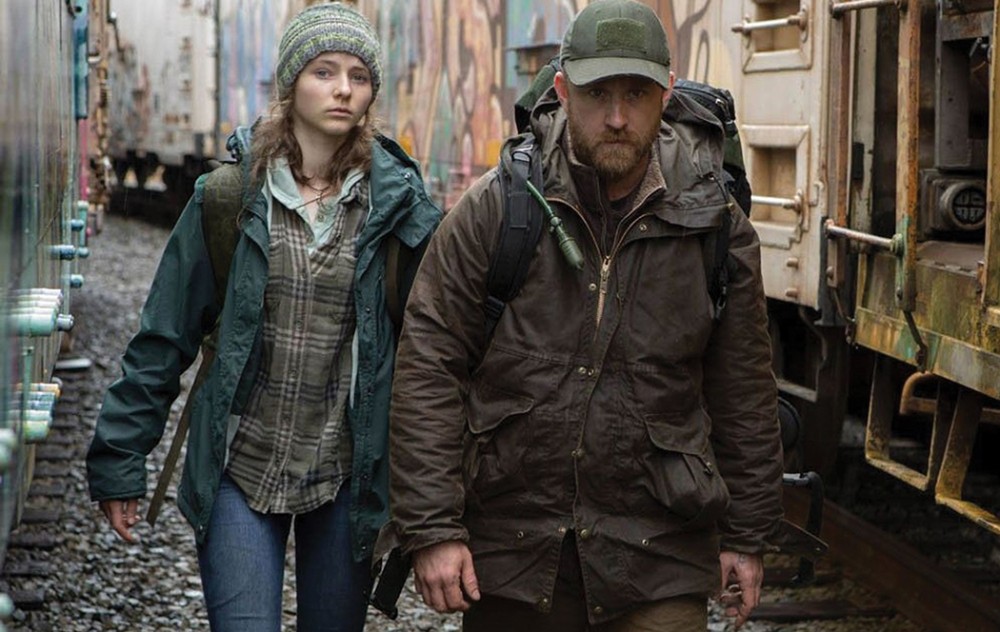In Leave No Trace, American life fails a veteran and his daughter
Debra Granik's film is a masterful familial drama—and much more.

My favorite movie of the summer is the quiet masterpiece Leave No Trace, directed by Debra Granik. It is a coming of age drama that is also about the country’s mistreatment of veterans, the devastation of PTSD, and the prospect of building a meaningful life in the ruins of a broken social order.
Will (Ben Foster) and Tom (Thomasin McKenzie) are a father and daughter living illegally on public land outside Portland, Oregon. We don’t know how long they have been there, but presumably most of Tom’s 13 years. The first 15 minutes of the film pass in near silence, revealing how the two go about their day-to-day life gathering food, kindling, and water; repairing their protective tarps; and homeschooling Tom through their collection of books. It is an isolated life, but it’s obvious they are happy—maybe happier than most of us can imagine.
Read our latest issue or browse back issues.
When they are discovered and forced back into society, they have to trade expansive freedom for the confines of a shabby house and alienated labor. The fall from their self-made Eden also includes Tom’s entrance into the knowledge of all that she has been missing.
Through Tom’s eyes, we see contemporary life with the startling clarity of an outsider—how instead of living among trees, we cut them down to amass wealth to buy things the trees used to provide; how instead of talking to people next to us on the bus, we take selfies for social media; how we go to church not out of love but to prove to our neighbors we are good people.
But Tom isn’t judging the people she’s watching, and neither is the movie. Will and Tom don’t live in the wilderness to escape corruption; they live there because Will cannot survive anywhere else. He is nearly paralyzed by PTSD except when he is in nature. In the woods, Tom is aware of the burden her father carries: he wakes from vivid nightmares and orders practice escape drills. Outside the woods, both his symptoms and her awareness of them increase even as she begins to notice forms of human community she’s been denied.
In this sense, Leave No Trace is a masterful familial drama. Will has succeeded in imbuing Tom’s life with vitality, meaningful skills, love, and a sense of awe, but even the best parent-child relationships have to face the truth that parent and child are not the same. As Tom says in a moment of heartrending clarity, what is broken in Will is not broken in her.
The drama of Tom’s coming of age underscores the film’s deeper preoccupation with the lengths to which some people have to go to reclaim a meaningful life. Will and Tom are betrayed at every turn by the systems that are supposed to support them. To deal with continuing effects of the trauma of war, Will is given psychiatric drugs, which he sells on the black market to veterans who are as broken as he is. The social workers tasked with evaluating and aiding Tom and Will do everything they can, but the systems still fail.
The movie holds out hope that people will find new forms of community despite the inadequacies of a bureaucratic state. With wide eyes and an open heart, Tom finds signs of hope everywhere, from a rabbit-grooming 4-H club to a small RV community deep in the Washington mountains. Most of the people she encounters are also fugitives: veterans waking from their own nightmares or farmers left behind by big agriculture. She sees in them what her father taught her to value about self-reliance and freedom from convention. But she also sees friendship and community that extend the care she learned in the small circle of her father’s love.
For all the film has to say about the limits and wounds of American life, it is not a political movie. There are no easy solutions to the systems that fail Will and Tom. The communities Tom finds are more like bands of refugees from a failed civilization than an alternative that could work on a large scale. Perhaps Will’s greatest lesson to Tom is a mantra they repeat, sometimes with hope, sometimes in desperation: “We can still think our own thoughts.” The movie invites us to do the same by showing us, with careful attention, people who are fighting to make meaningful lives on the margins of middle-class normalcy. As the middle class evaporates and wars continue to be waged, we may all have a lot to learn from Will and Tom’s journey in and out of the woods.
A version of this article appears in the print edition under the title “Outside looking in.”






